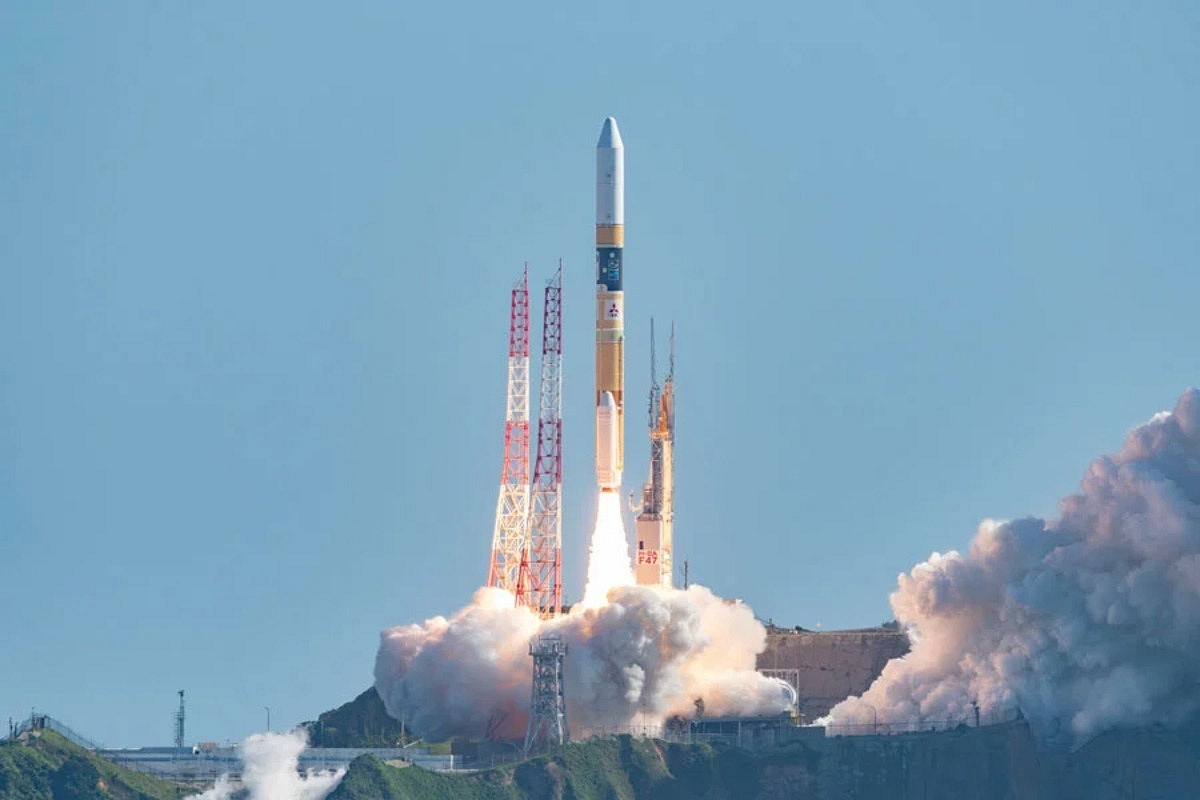Science
Japan Successfully Launches Mission To Moon, Plus A Probe Closer Home To Reveal Universe In X-rays
- Japan has launched two exciting missions related to lunar and space science in one shot, using a single rocket.

JAXA rocket launch carrying aboard XRISM and SLIM (Photo: Mitsubishi Heavy Industries)
After three rounds of delays due to unfavourable weather conditions, Japan's space science and Moon mission finally lifted off on Thursday (7 September) at 5.12 am, India time.
The X-ray Imaging and Spectroscopy Mission (XRISM) and the Smart Lander for Investigating Moon (SLIM) were launched on board the H-IIA Launch Vehicle No 47 (H-IIA F47) from the Tanegashima Space Center.
Mitsubishi Heavy Industries (MHI) provided the launch vehicle service for the Japan Aerospace Exploration Agency (JAXA).
"The launch vehicle flew as planned, and it was confirmed that XRISM was successfully separated from the launch vehicle at about 14 minutes and 9 seconds after launch and SLIM at about 47 minutes and 33 seconds after launch," JAXA said.
The Indian Space Research Organisation (ISRO), which recently executed a successful Moon mission demonstrating soft-landing, roving, and scientific experiments on the lunar surface, congratulated the Japanese space agency on the successful launch of its SLIM lunar lander.
"Best wishes for another successful lunar endeavour by the global space community," ISRO said.
Japan's SLIM project is a vehicle for the research and development of pinpoint landing technology that aims to improve future lunar exploration.
The technology developed thus far will be put to the test on the lunar surface with the SLIM small-scale lunar lander now headed to the Moon with eyes on a precise touchdown.
The Japanese lander will enable humans to "make a qualitative shift towards being able to land where we want and not just where it is easy to land," says the Institute of Space and Astronautical Science (ISAS), a principal space science research contributor to JAXA.
"By achieving this, it will become possible to land on planets even more resource scarce than the moon," ISAS says.
SLIM, also known as "Moon Sniper" in Japanese, will take its time to reach the Moon. It is expected to arrive in lunar orbit approximately three to four months after launch.
Following a further month in orbit, the spacecraft will make a 20-minute dash to the lunar surface, aiming to land within 100 metres of its intended target.
This precision landing is crucial, as traditional landers have an accuracy of several kilometres.
XRISM, on the other hand, is focused on exploring the universe through X-rays. It carries a state-of-the-art spectrometre with 30 times higher energy resolution than conventional spectrometres.
JAXA is collaborating on this mission with the National Aeronautics and Space Administration (NASA), European Space Agency (ESA), and various local research institutes.
XRISM aims to probe the structural formation of the universe and the evolution of galaxy clusters, in addition to the history of material circulation and energy transport in the universe.
It will study high-temperature gases in space. These gases can range from temperatures of hundreds to tens of millions of degrees Celsius.
The mission aims to build new science through the use of ultra-high-resolution X-ray spectroscopy.
The X-ray observatory — Japan's seventh — is equipped with two instruments: Resolve and Xtend.
They are designed to capture and analyse X-ray images and spectra, providing valuable data and insights into the properties and behaviour of high-temperature gases in the universe.
Resolve is a soft X-ray spectrometre, equipped with a lightweight X-ray mirror assembly and an X-ray calorimetre spectrometre, to measure the "colour" of X-rays in detail.
Xtend is a soft X-ray imager that can observe an area of the sky equivalent to one full moon at a time.
The XRISM observatory will be available to the international scientific community, JAXA said.
The Earth-orbit probe is expected to survey the skies for a period of three years, until the cooling helium tanks, which maintain its operational temperature at -273.10 degrees Celsius, are depleted.
As for its lunar mission, if it happens to be successful, Japan will join the ranks of just five countries that have achieved a soft landing on the Moon.
The Japanese launch follows closely on the heels of India's historic Moon mission in Chandrayaan-3.
India recently became only the fourth country to accomplish soft landing on the Moon and the first to do in the south pole region.
Support Swarajya's 50 Ground Reports Project & Sponsor A Story
Every general election Swarajya does a 50 ground reports project.
Aimed only at serious readers and those who appreciate the nuances of political undercurrents, the project provides a sense of India's electoral landscape. As you know, these reports are produced after considerable investment of travel, time and effort on the ground.
This time too we've kicked off the project in style and have covered over 30 constituencies already. If you're someone who appreciates such work and have enjoyed our coverage please consider sponsoring a ground report for just Rs 2999 to Rs 19,999 - it goes a long way in helping us produce more quality reportage.
You can also back this project by becoming a subscriber for as little as Rs 999 - so do click on this links and choose a plan that suits you and back us.
Click below to contribute.
Latest